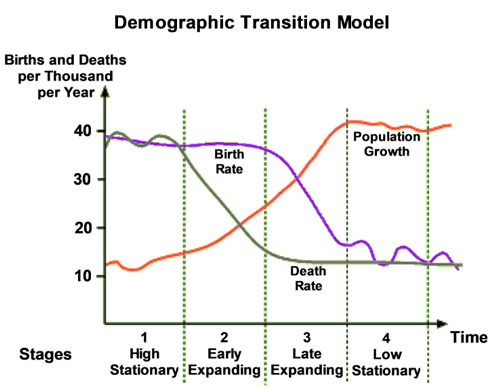Demographic Transition Model (original) (raw)
The changes in population growth rates and the effect on population can be shown on the Demographic Transition Model(Population Cycle) - see diagram below:

This can be divided into four stages:
Stage 1 - High Fluctuating
Birth Rate and Death rate are both high. Population growth is slow and fluctuating.
Reasons
Birth Rate is high as a result of:
- Lack of family planning
- High Infant Mortality Rate: putting babies in the 'bank'
- Need for workers in agriculture
- Religious beliefs
- Children as economic assets
Death Rate is high because of:
- High levels of disease
- Famine
- Lack of clean water and sanitation
- Lack of health care
- War
- Competition for food from predators such as rats
- Lack of education
Typical of Britain in the 18th century and the Least Economically Developed Countries (LEDC's) today.
Stage 2 - Early Expanding
Birth Rate remains high. Death Rate is falling. Population begins to rise steadily.
Reasons
Death Rate is falling as a result of:
- Improved health care (e.g. Smallpox Vaccine)
- Improved Hygiene (Water for drinking boiled)
- Improved sanitation
- Improved food production and storage
- Improved transport for food
- Decreased Infant Mortality Rates
Typical of Britain in 19th century; Bangladesh; Nigeria
Stage 3 - Late Expanding
Birth Rate starts to fall. Death Rate continues to fall. Population rising.
Reasons
- Family planning available
- Lower Infant Mortality Rate
- Increased mechanization reduces need for workers
- Increased standard of living
- Changing status of women
Typical of Britain in late 19th and early 20th century; China; Brazil
Stage 4 - Low Fluctuating
Birth Rate and Death Rate both low. Population steady.
Typical of USA; Sweden; Japan; Britain
Demographic Transition Model Applied Revision Table
| Area | Birth Rate | Reason | Death Rate | Reason |
|---|---|---|---|---|
| LEDCs | High | No contraceptionCouples have many babies to compensate for the high death rate caused by poor health careLarge families need to work on the land to contribute to family incomeChildren look after oldReligious reasons | High | Poor medical facilitiesDiseasePoor nutritionHigh Infant mortality |
| NICs | High/Decreasing | People are used to having many children. Takes time for culture to changeChanging status of women | Decreasing | As an economy develops money becomes available for better health careHousing improvesBetter childcare |
| MEDCs | Low | Children are expensivePeople know their children are going to survive so they can keep their families smallWidely available contraceptivesChanging status of women | Low | Better health careBetter standard of living |
Is the model universally applicable?
Like all models, the demographic transition model has its limitations. It failed to consider, or to predict, several factors and events:
1 Birth rates in several MEDCs have fallen below death rates (Germany, Sweden). This has caused, for the first time, a population decline which suggests that perhaps the model should have a fifth stage added to it.
2 The model assumes that in time all countries pass through the same four stages. It now seems unlikely, however, that many LEDCs, especially in Africa, will ever become industrialised.
3 The model assumes that the fall in the death rate in Stage 2 was the consequence of industrialisation. Initially, the death rate in many British cities rose, due to the insanitary conditions which resulted from rapid urban growth, and it only began to fall after advances were made in medicine. The delayed fall in the death rate in many developing countries has been due mainly to their inability to afford medical facilities. In many countries, the fall in the birth rate in Stage 3 has been less rapid than the model suggests due to religious and/or political opposition to birth control (Brazil), whereas the fall was much more rapid, and came earlier, in China following the government-introduced ‘onechild’ policy.
The timescale of the model, especially in several South-east Asian countries such as Hong Kong and Malaysia, is being squashed as they develop at a much faster rate than did the early industrialised countries.
4 Countries that grew as a consequence of emigration from Europe (USA, Canada, Australia) did not pass through the early stages of the model.